Business Operations Report: TESCO's Performance and Strategies
VerifiedAdded on 2020/06/04
|10
|2140
|56
Report
AI Summary
This report provides a comprehensive analysis of TESCO's business operations, examining various internal and external factors affecting its performance. It delves into the importance of accounting for business success, highlighting its role in financial management, budgeting, and profit/loss analysis. The report also explores the different functions of the HR department, including recruitment, staffing, training, and employee relations, as well as key features of employment legislation. Furthermore, it includes an analysis of a TESCO profit and loss statement and an examination of team development phases, motivational theories such as Maslow's and Herzberg's, and various leadership styles employed within the organization. The report concludes by emphasizing the importance of aligning business strategies with market demands to enhance overall performance and customer satisfaction. This analysis provides valuable insights into the operations and strategies of a major retail corporation.
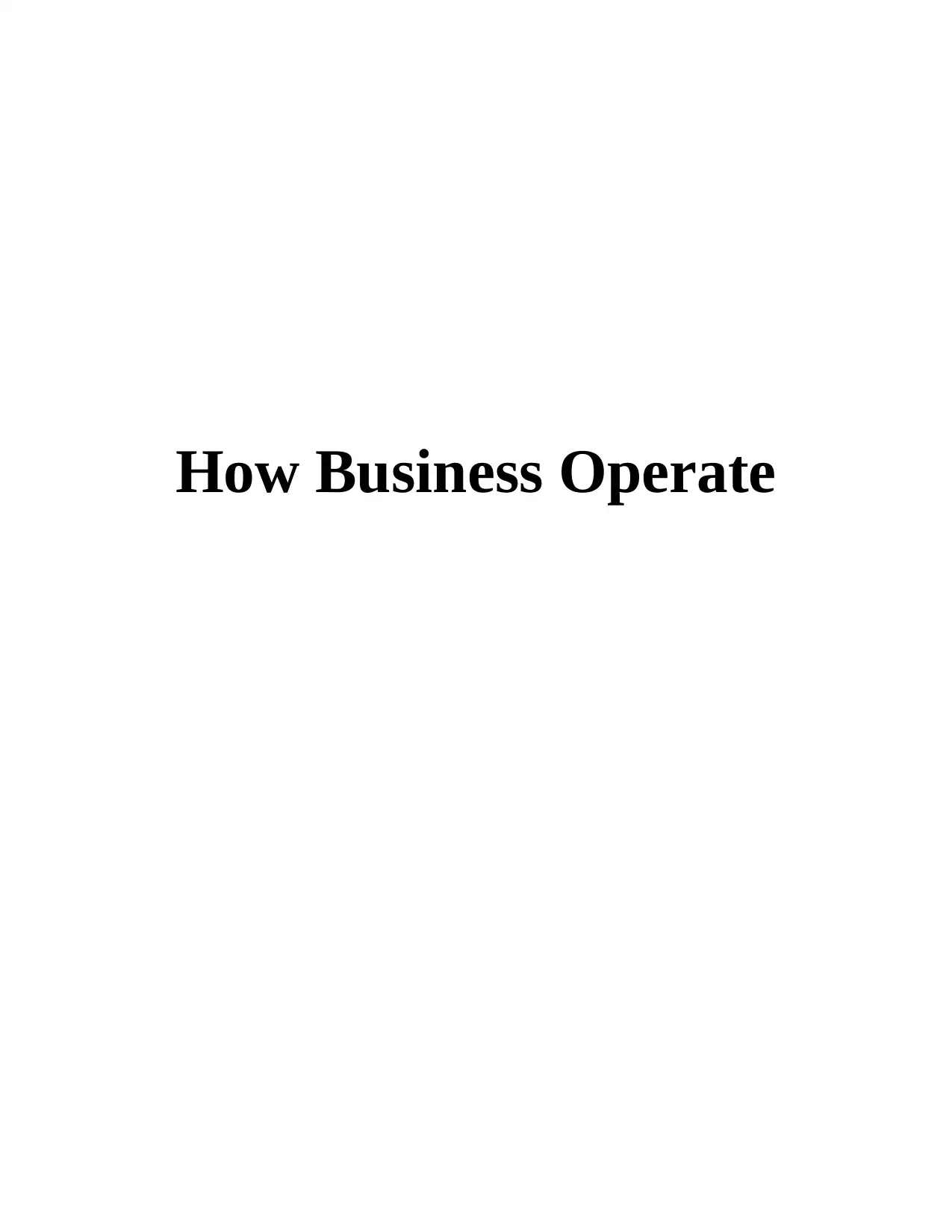
How Business Operate
Paraphrase This Document
Need a fresh take? Get an instant paraphrase of this document with our AI Paraphraser

Table of Contents
INTRODUCTION...........................................................................................................................1
TASK 1............................................................................................................................................1
TASK 2............................................................................................................................................1
2.1 Importance of accounting for business success....................................................................1
5.1 Different functions of HR department in business................................................................2
5.2 Key features of employment legislation...............................................................................2
TASK 3............................................................................................................................................3
3.1 Accounting workshop...........................................................................................................3
TASK 4............................................................................................................................................3
4.1 An analysis to determine own and other's roles of team members.......................................3
4.2 Team Development...............................................................................................................4
TASK 5............................................................................................................................................5
CONCLUSION................................................................................................................................5
REFERENCES................................................................................................................................7
INTRODUCTION...........................................................................................................................1
TASK 1............................................................................................................................................1
TASK 2............................................................................................................................................1
2.1 Importance of accounting for business success....................................................................1
5.1 Different functions of HR department in business................................................................2
5.2 Key features of employment legislation...............................................................................2
TASK 3............................................................................................................................................3
3.1 Accounting workshop...........................................................................................................3
TASK 4............................................................................................................................................3
4.1 An analysis to determine own and other's roles of team members.......................................3
4.2 Team Development...............................................................................................................4
TASK 5............................................................................................................................................5
CONCLUSION................................................................................................................................5
REFERENCES................................................................................................................................7

⊘ This is a preview!⊘
Do you want full access?
Subscribe today to unlock all pages.

Trusted by 1+ million students worldwide

INTRODUCTION
Business environment consists various internal and external factors such as government,
customers, suppliers, competitors, etc. and acknowledge their impact on business operations.
This help administration to have complete information about market conditions and system
capabilities. HR, finance, production, marketing, research and development are various
departments which are present in public and private organisations (Sekaran and Bougie, 2016).
Present report is based on TESCO, which is famous retail store established in UK and other
nations. Employer responsibility is to have adequate manpower so that activities are executed in
appropriate manner. Along this, superior duty is to keep teammates motivated and dedicated
towards job; thereby make them perform tasks effectively and attain targets within defined time.
TASK 1
COVERED IN PPT.
TASK 2
2.1 Importance of accounting for business success
Executive require to have adequate capital, so that business operations are executed
adequately. It is necessary that administration utilises funds, material and manpower efficiently;
thereby deliver appropriate items and services in marketplace (Bryman and Bell, 2015). Thus,
these are various benefits that accounting process has on business growth and prosperity are as
follows:
Finance department members construct budget that will be incurred to execute activities
effectively.
Expenses and incomes are recorded by management, so that organisation have adequate
information about availability of funds.
Administration is able to acknowledge operational profit or loss that are ascertained from
business operations.
Accounting helps seniors to get accurate information about market position and financial
status of firm.
1
Business environment consists various internal and external factors such as government,
customers, suppliers, competitors, etc. and acknowledge their impact on business operations.
This help administration to have complete information about market conditions and system
capabilities. HR, finance, production, marketing, research and development are various
departments which are present in public and private organisations (Sekaran and Bougie, 2016).
Present report is based on TESCO, which is famous retail store established in UK and other
nations. Employer responsibility is to have adequate manpower so that activities are executed in
appropriate manner. Along this, superior duty is to keep teammates motivated and dedicated
towards job; thereby make them perform tasks effectively and attain targets within defined time.
TASK 1
COVERED IN PPT.
TASK 2
2.1 Importance of accounting for business success
Executive require to have adequate capital, so that business operations are executed
adequately. It is necessary that administration utilises funds, material and manpower efficiently;
thereby deliver appropriate items and services in marketplace (Bryman and Bell, 2015). Thus,
these are various benefits that accounting process has on business growth and prosperity are as
follows:
Finance department members construct budget that will be incurred to execute activities
effectively.
Expenses and incomes are recorded by management, so that organisation have adequate
information about availability of funds.
Administration is able to acknowledge operational profit or loss that are ascertained from
business operations.
Accounting helps seniors to get accurate information about market position and financial
status of firm.
1
Paraphrase This Document
Need a fresh take? Get an instant paraphrase of this document with our AI Paraphraser

5.1 Different functions of HR department in business
Employer responsibility is to have adequate manpower and skilled workforce so that
business operations are conducted appropriately. These are various activities that are performed
by human resource are described below:
Recruitment: HR manager execute this task to fill vacant positions and employ new
individuals to increase workforce. Internal and external approaches such as promotion, transfer,
employment agencies and professional institutions are various methods; that are used by
employer to recruit appropriate candidate (Murillo and Vallentin, 2016).
Staffing: Employer conducts group discussion, aptitude test and interview to
acknowledge skills and abilities of applicants; thereby select best candidate which have
capabilities required by management. It is essential that members are given duties and tasks on
basis of their knowledge, so they will perform activities effectively and complete targets within
defined time.
Training and development: Management conduct performance appraisal to anticipate
abilities of members by comparing actual outcomes with standards that were provided to them.
Thus, sessions and seminars are conducted by human resource to enhance skills and knowledge
of employees and make them capable to handle difficulties and challenges adequately.
Employee relations: Employer establish friendly bond with members to keep them
motivated and dedicated towards job. Along this, they are able to anticipate issues and conflicts
faced by staff and provide them appropriate solutions (Santos, Pache and Birkholz, 2015).
5.2 Key features of employment legislation
Government frame various policies and regulations to protect rights of members and take
care that employer provide adequate working conditions and benefits to staff. These are various
characteristics that employment legislations comprises are stated below:
Government has constituted health and safety act, so employees get positive and secure
working environment in organisation. Along this, individuals get appropriate working
hours and duration so employees health and mental ability remain affected.
Discrimination act defines that employer should give fair treatment to members and don't
make them distinct on basis of their caste, religion, gender and other background aspects.
2
Employer responsibility is to have adequate manpower and skilled workforce so that
business operations are conducted appropriately. These are various activities that are performed
by human resource are described below:
Recruitment: HR manager execute this task to fill vacant positions and employ new
individuals to increase workforce. Internal and external approaches such as promotion, transfer,
employment agencies and professional institutions are various methods; that are used by
employer to recruit appropriate candidate (Murillo and Vallentin, 2016).
Staffing: Employer conducts group discussion, aptitude test and interview to
acknowledge skills and abilities of applicants; thereby select best candidate which have
capabilities required by management. It is essential that members are given duties and tasks on
basis of their knowledge, so they will perform activities effectively and complete targets within
defined time.
Training and development: Management conduct performance appraisal to anticipate
abilities of members by comparing actual outcomes with standards that were provided to them.
Thus, sessions and seminars are conducted by human resource to enhance skills and knowledge
of employees and make them capable to handle difficulties and challenges adequately.
Employee relations: Employer establish friendly bond with members to keep them
motivated and dedicated towards job. Along this, they are able to anticipate issues and conflicts
faced by staff and provide them appropriate solutions (Santos, Pache and Birkholz, 2015).
5.2 Key features of employment legislation
Government frame various policies and regulations to protect rights of members and take
care that employer provide adequate working conditions and benefits to staff. These are various
characteristics that employment legislations comprises are stated below:
Government has constituted health and safety act, so employees get positive and secure
working environment in organisation. Along this, individuals get appropriate working
hours and duration so employees health and mental ability remain affected.
Discrimination act defines that employer should give fair treatment to members and don't
make them distinct on basis of their caste, religion, gender and other background aspects.
2
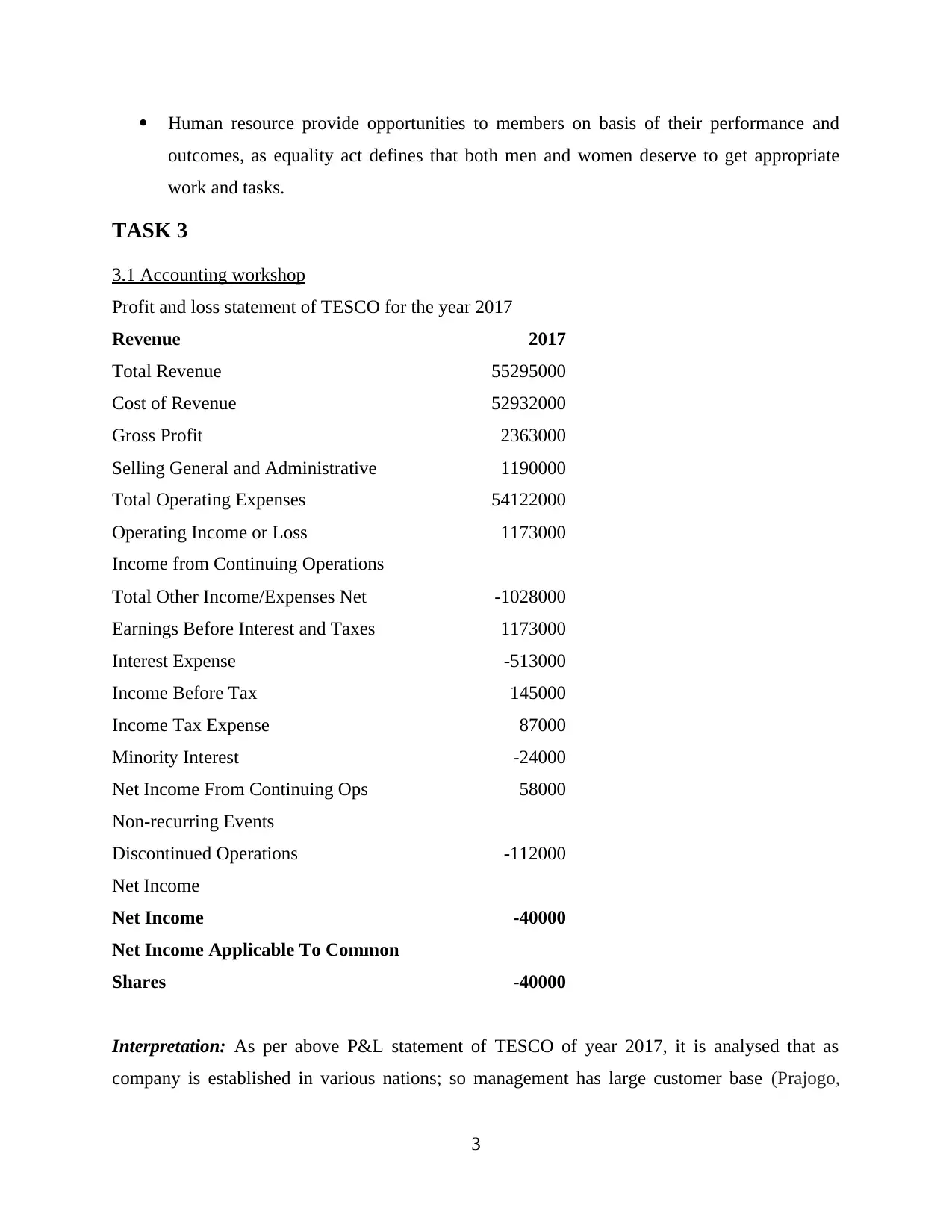
Human resource provide opportunities to members on basis of their performance and
outcomes, as equality act defines that both men and women deserve to get appropriate
work and tasks.
TASK 3
3.1 Accounting workshop
Profit and loss statement of TESCO for the year 2017
Revenue 2017
Total Revenue 55295000
Cost of Revenue 52932000
Gross Profit 2363000
Selling General and Administrative 1190000
Total Operating Expenses 54122000
Operating Income or Loss 1173000
Income from Continuing Operations
Total Other Income/Expenses Net -1028000
Earnings Before Interest and Taxes 1173000
Interest Expense -513000
Income Before Tax 145000
Income Tax Expense 87000
Minority Interest -24000
Net Income From Continuing Ops 58000
Non-recurring Events
Discontinued Operations -112000
Net Income
Net Income -40000
Net Income Applicable To Common
Shares -40000
Interpretation: As per above P&L statement of TESCO of year 2017, it is analysed that as
company is established in various nations; so management has large customer base (Prajogo,
3
outcomes, as equality act defines that both men and women deserve to get appropriate
work and tasks.
TASK 3
3.1 Accounting workshop
Profit and loss statement of TESCO for the year 2017
Revenue 2017
Total Revenue 55295000
Cost of Revenue 52932000
Gross Profit 2363000
Selling General and Administrative 1190000
Total Operating Expenses 54122000
Operating Income or Loss 1173000
Income from Continuing Operations
Total Other Income/Expenses Net -1028000
Earnings Before Interest and Taxes 1173000
Interest Expense -513000
Income Before Tax 145000
Income Tax Expense 87000
Minority Interest -24000
Net Income From Continuing Ops 58000
Non-recurring Events
Discontinued Operations -112000
Net Income
Net Income -40000
Net Income Applicable To Common
Shares -40000
Interpretation: As per above P&L statement of TESCO of year 2017, it is analysed that as
company is established in various nations; so management has large customer base (Prajogo,
3
⊘ This is a preview!⊘
Do you want full access?
Subscribe today to unlock all pages.

Trusted by 1+ million students worldwide
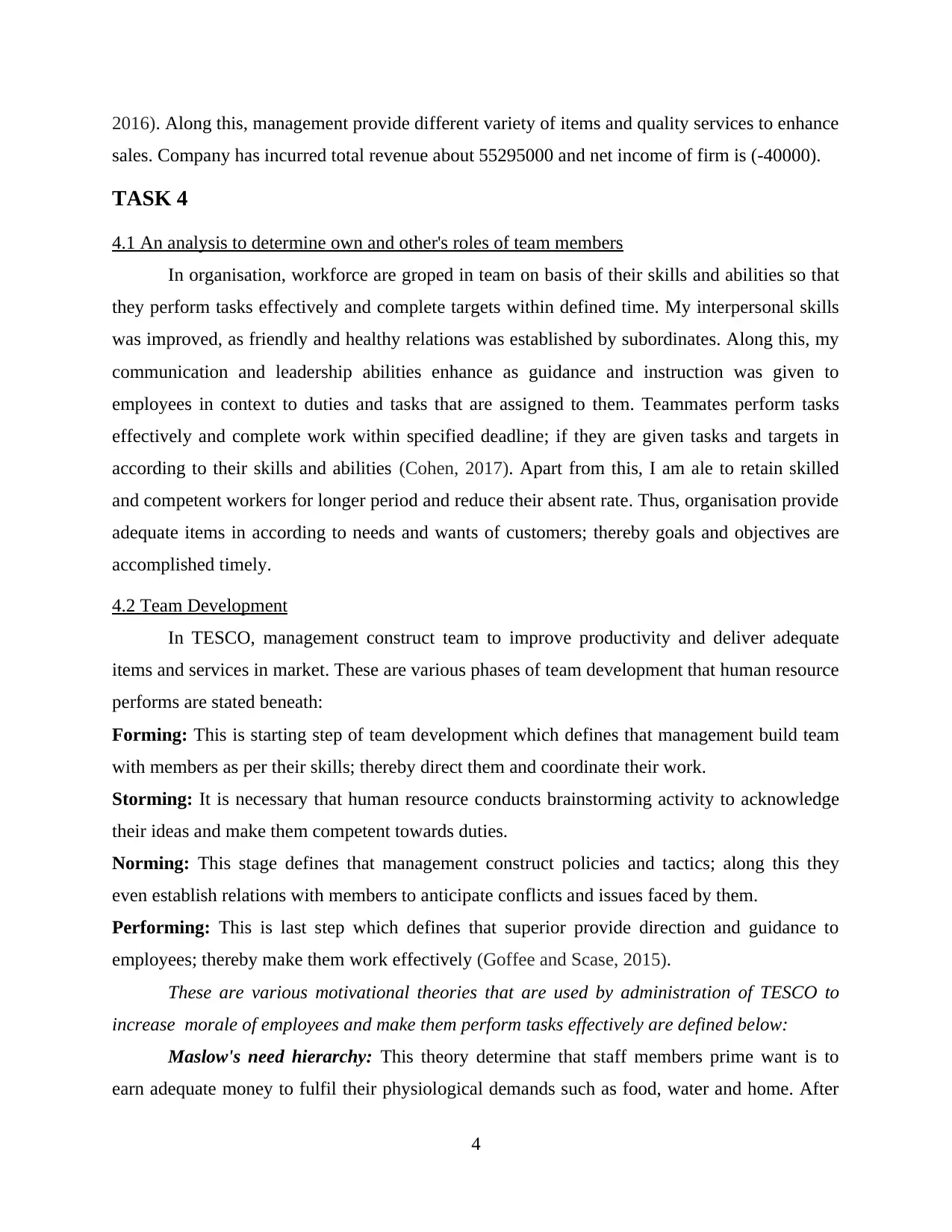
2016). Along this, management provide different variety of items and quality services to enhance
sales. Company has incurred total revenue about 55295000 and net income of firm is (-40000).
TASK 4
4.1 An analysis to determine own and other's roles of team members
In organisation, workforce are groped in team on basis of their skills and abilities so that
they perform tasks effectively and complete targets within defined time. My interpersonal skills
was improved, as friendly and healthy relations was established by subordinates. Along this, my
communication and leadership abilities enhance as guidance and instruction was given to
employees in context to duties and tasks that are assigned to them. Teammates perform tasks
effectively and complete work within specified deadline; if they are given tasks and targets in
according to their skills and abilities (Cohen, 2017). Apart from this, I am ale to retain skilled
and competent workers for longer period and reduce their absent rate. Thus, organisation provide
adequate items in according to needs and wants of customers; thereby goals and objectives are
accomplished timely.
4.2 Team Development
In TESCO, management construct team to improve productivity and deliver adequate
items and services in market. These are various phases of team development that human resource
performs are stated beneath:
Forming: This is starting step of team development which defines that management build team
with members as per their skills; thereby direct them and coordinate their work.
Storming: It is necessary that human resource conducts brainstorming activity to acknowledge
their ideas and make them competent towards duties.
Norming: This stage defines that management construct policies and tactics; along this they
even establish relations with members to anticipate conflicts and issues faced by them.
Performing: This is last step which defines that superior provide direction and guidance to
employees; thereby make them work effectively (Goffee and Scase, 2015).
These are various motivational theories that are used by administration of TESCO to
increase morale of employees and make them perform tasks effectively are defined below:
Maslow's need hierarchy: This theory determine that staff members prime want is to
earn adequate money to fulfil their physiological demands such as food, water and home. After
4
sales. Company has incurred total revenue about 55295000 and net income of firm is (-40000).
TASK 4
4.1 An analysis to determine own and other's roles of team members
In organisation, workforce are groped in team on basis of their skills and abilities so that
they perform tasks effectively and complete targets within defined time. My interpersonal skills
was improved, as friendly and healthy relations was established by subordinates. Along this, my
communication and leadership abilities enhance as guidance and instruction was given to
employees in context to duties and tasks that are assigned to them. Teammates perform tasks
effectively and complete work within specified deadline; if they are given tasks and targets in
according to their skills and abilities (Cohen, 2017). Apart from this, I am ale to retain skilled
and competent workers for longer period and reduce their absent rate. Thus, organisation provide
adequate items in according to needs and wants of customers; thereby goals and objectives are
accomplished timely.
4.2 Team Development
In TESCO, management construct team to improve productivity and deliver adequate
items and services in market. These are various phases of team development that human resource
performs are stated beneath:
Forming: This is starting step of team development which defines that management build team
with members as per their skills; thereby direct them and coordinate their work.
Storming: It is necessary that human resource conducts brainstorming activity to acknowledge
their ideas and make them competent towards duties.
Norming: This stage defines that management construct policies and tactics; along this they
even establish relations with members to anticipate conflicts and issues faced by them.
Performing: This is last step which defines that superior provide direction and guidance to
employees; thereby make them work effectively (Goffee and Scase, 2015).
These are various motivational theories that are used by administration of TESCO to
increase morale of employees and make them perform tasks effectively are defined below:
Maslow's need hierarchy: This theory determine that staff members prime want is to
earn adequate money to fulfil their physiological demands such as food, water and home. After
4
Paraphrase This Document
Need a fresh take? Get an instant paraphrase of this document with our AI Paraphraser
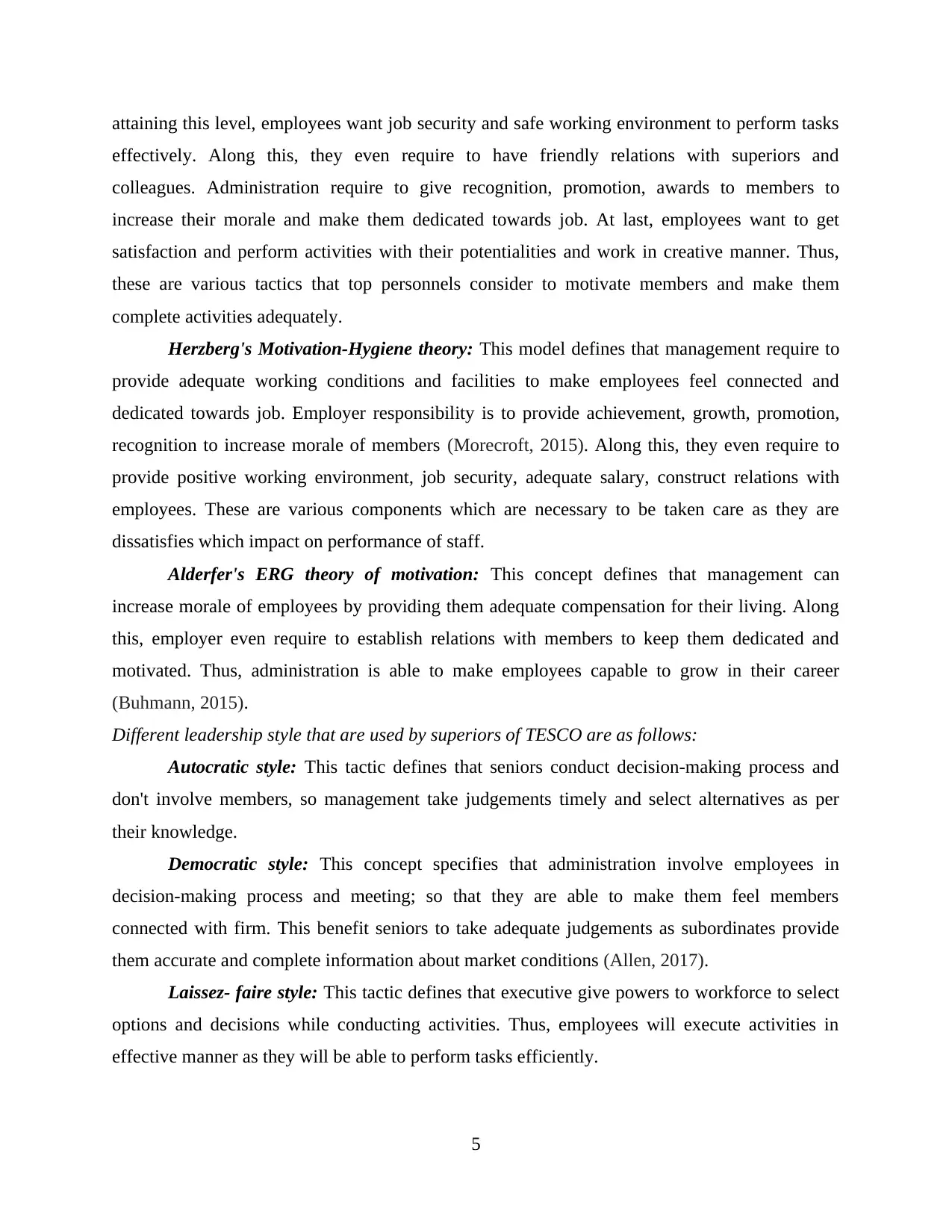
attaining this level, employees want job security and safe working environment to perform tasks
effectively. Along this, they even require to have friendly relations with superiors and
colleagues. Administration require to give recognition, promotion, awards to members to
increase their morale and make them dedicated towards job. At last, employees want to get
satisfaction and perform activities with their potentialities and work in creative manner. Thus,
these are various tactics that top personnels consider to motivate members and make them
complete activities adequately.
Herzberg's Motivation-Hygiene theory: This model defines that management require to
provide adequate working conditions and facilities to make employees feel connected and
dedicated towards job. Employer responsibility is to provide achievement, growth, promotion,
recognition to increase morale of members (Morecroft, 2015). Along this, they even require to
provide positive working environment, job security, adequate salary, construct relations with
employees. These are various components which are necessary to be taken care as they are
dissatisfies which impact on performance of staff.
Alderfer's ERG theory of motivation: This concept defines that management can
increase morale of employees by providing them adequate compensation for their living. Along
this, employer even require to establish relations with members to keep them dedicated and
motivated. Thus, administration is able to make employees capable to grow in their career
(Buhmann, 2015).
Different leadership style that are used by superiors of TESCO are as follows:
Autocratic style: This tactic defines that seniors conduct decision-making process and
don't involve members, so management take judgements timely and select alternatives as per
their knowledge.
Democratic style: This concept specifies that administration involve employees in
decision-making process and meeting; so that they are able to make them feel members
connected with firm. This benefit seniors to take adequate judgements as subordinates provide
them accurate and complete information about market conditions (Allen, 2017).
Laissez- faire style: This tactic defines that executive give powers to workforce to select
options and decisions while conducting activities. Thus, employees will execute activities in
effective manner as they will be able to perform tasks efficiently.
5
effectively. Along this, they even require to have friendly relations with superiors and
colleagues. Administration require to give recognition, promotion, awards to members to
increase their morale and make them dedicated towards job. At last, employees want to get
satisfaction and perform activities with their potentialities and work in creative manner. Thus,
these are various tactics that top personnels consider to motivate members and make them
complete activities adequately.
Herzberg's Motivation-Hygiene theory: This model defines that management require to
provide adequate working conditions and facilities to make employees feel connected and
dedicated towards job. Employer responsibility is to provide achievement, growth, promotion,
recognition to increase morale of members (Morecroft, 2015). Along this, they even require to
provide positive working environment, job security, adequate salary, construct relations with
employees. These are various components which are necessary to be taken care as they are
dissatisfies which impact on performance of staff.
Alderfer's ERG theory of motivation: This concept defines that management can
increase morale of employees by providing them adequate compensation for their living. Along
this, employer even require to establish relations with members to keep them dedicated and
motivated. Thus, administration is able to make employees capable to grow in their career
(Buhmann, 2015).
Different leadership style that are used by superiors of TESCO are as follows:
Autocratic style: This tactic defines that seniors conduct decision-making process and
don't involve members, so management take judgements timely and select alternatives as per
their knowledge.
Democratic style: This concept specifies that administration involve employees in
decision-making process and meeting; so that they are able to make them feel members
connected with firm. This benefit seniors to take adequate judgements as subordinates provide
them accurate and complete information about market conditions (Allen, 2017).
Laissez- faire style: This tactic defines that executive give powers to workforce to select
options and decisions while conducting activities. Thus, employees will execute activities in
effective manner as they will be able to perform tasks efficiently.
5
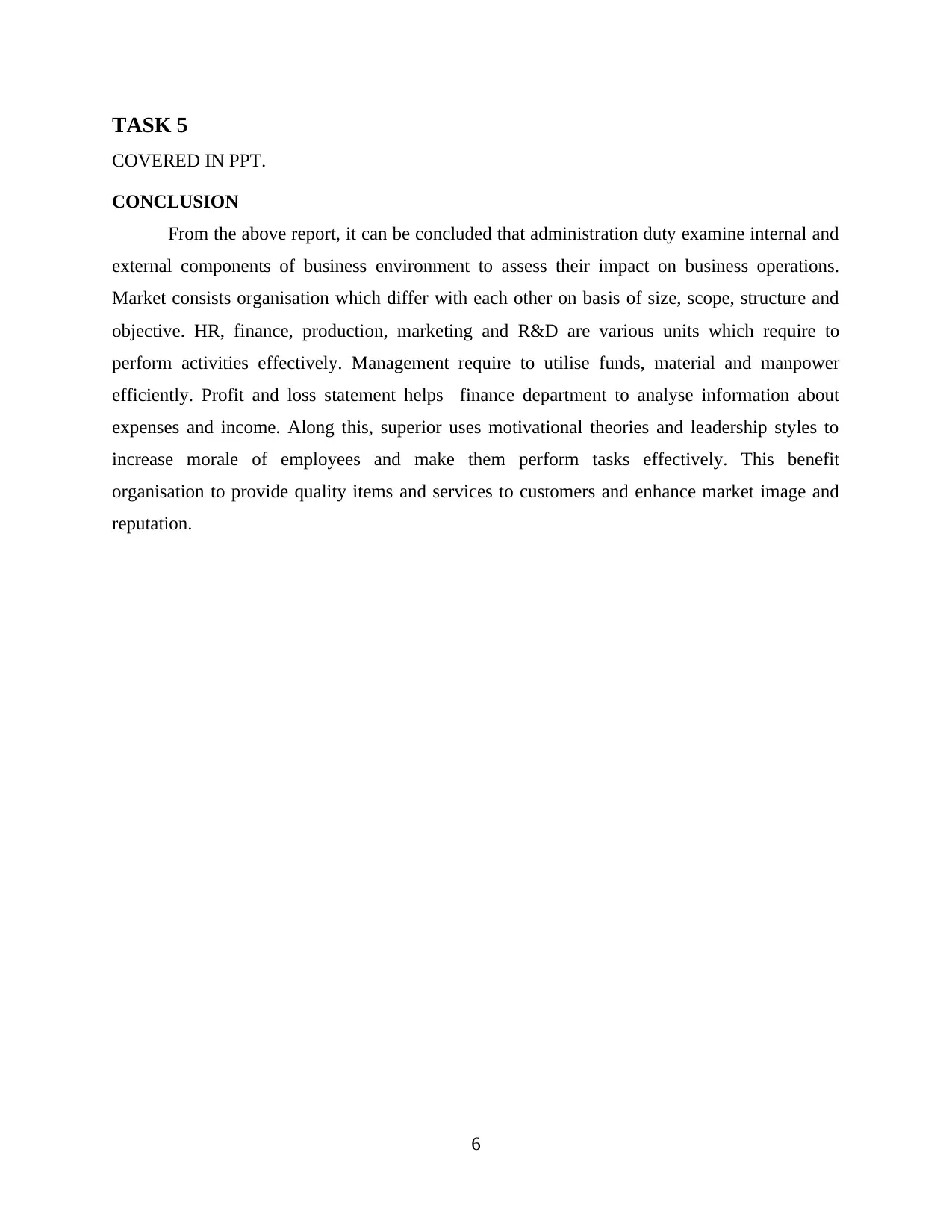
TASK 5
COVERED IN PPT.
CONCLUSION
From the above report, it can be concluded that administration duty examine internal and
external components of business environment to assess their impact on business operations.
Market consists organisation which differ with each other on basis of size, scope, structure and
objective. HR, finance, production, marketing and R&D are various units which require to
perform activities effectively. Management require to utilise funds, material and manpower
efficiently. Profit and loss statement helps finance department to analyse information about
expenses and income. Along this, superior uses motivational theories and leadership styles to
increase morale of employees and make them perform tasks effectively. This benefit
organisation to provide quality items and services to customers and enhance market image and
reputation.
6
COVERED IN PPT.
CONCLUSION
From the above report, it can be concluded that administration duty examine internal and
external components of business environment to assess their impact on business operations.
Market consists organisation which differ with each other on basis of size, scope, structure and
objective. HR, finance, production, marketing and R&D are various units which require to
perform activities effectively. Management require to utilise funds, material and manpower
efficiently. Profit and loss statement helps finance department to analyse information about
expenses and income. Along this, superior uses motivational theories and leadership styles to
increase morale of employees and make them perform tasks effectively. This benefit
organisation to provide quality items and services to customers and enhance market image and
reputation.
6
⊘ This is a preview!⊘
Do you want full access?
Subscribe today to unlock all pages.

Trusted by 1+ million students worldwide

REFERENCES
Books and Journals
Allen, W. T., 2017. Our schizophrenic conception of the business corporation. In Corporate
Governance. pp. 79-99. Gower.
Bryman, A. and Bell, E., 2015. Business research methods. Oxford University Press, USA.
Buhmann, K., 2015. Public Regulators and CSR: The ‘Social Licence to Operate’in Recent
United Nations Instruments on Business and Human Rights and the Juridification of
CSR.
Cohen, T., 2017. HTM Departments Should Operate like a Business. Biomedical instrumentation
& technology. 51(4). pp.301-305.
Goffee, R. and Scase, R., 2015. The Real World of the Small Business Owner (Routledge
Revivals). Routledge.
Morecroft, J. D., 2015. Strategic modelling and business dynamics: a feedback systems
approach. John Wiley & Sons.
Murillo, D. and Vallentin, S., 2016. The business school’s right to operate: Responsibilization
and resistance. Journal of business ethics. 136(4). pp.743-757.
Prajogo, D. I., 2016. The strategic fit between innovation strategies and business environment in
delivering business performance. International Journal of Production Economics. 171.
pp.241-249.
Santos, F., Pache, A. C. and Birkholz, C., 2015. Making hybrids work: Aligning business models
and organizational design for social enterprises. California Management Review. 57(3).
pp.36-58.
Sekaran, U. and Bougie, R., 2016. Research methods for business: A skill building approach.
John Wiley & Sons.
7
Books and Journals
Allen, W. T., 2017. Our schizophrenic conception of the business corporation. In Corporate
Governance. pp. 79-99. Gower.
Bryman, A. and Bell, E., 2015. Business research methods. Oxford University Press, USA.
Buhmann, K., 2015. Public Regulators and CSR: The ‘Social Licence to Operate’in Recent
United Nations Instruments on Business and Human Rights and the Juridification of
CSR.
Cohen, T., 2017. HTM Departments Should Operate like a Business. Biomedical instrumentation
& technology. 51(4). pp.301-305.
Goffee, R. and Scase, R., 2015. The Real World of the Small Business Owner (Routledge
Revivals). Routledge.
Morecroft, J. D., 2015. Strategic modelling and business dynamics: a feedback systems
approach. John Wiley & Sons.
Murillo, D. and Vallentin, S., 2016. The business school’s right to operate: Responsibilization
and resistance. Journal of business ethics. 136(4). pp.743-757.
Prajogo, D. I., 2016. The strategic fit between innovation strategies and business environment in
delivering business performance. International Journal of Production Economics. 171.
pp.241-249.
Santos, F., Pache, A. C. and Birkholz, C., 2015. Making hybrids work: Aligning business models
and organizational design for social enterprises. California Management Review. 57(3).
pp.36-58.
Sekaran, U. and Bougie, R., 2016. Research methods for business: A skill building approach.
John Wiley & Sons.
7
1 out of 10
Related Documents
Your All-in-One AI-Powered Toolkit for Academic Success.
+13062052269
info@desklib.com
Available 24*7 on WhatsApp / Email
![[object Object]](/_next/static/media/star-bottom.7253800d.svg)
Unlock your academic potential
Copyright © 2020–2025 A2Z Services. All Rights Reserved. Developed and managed by ZUCOL.





